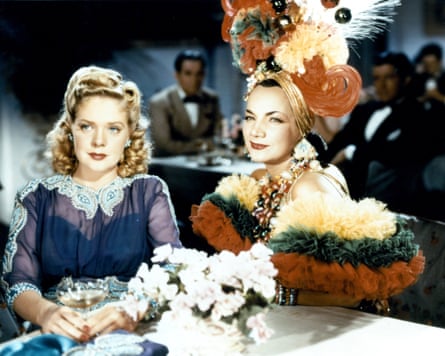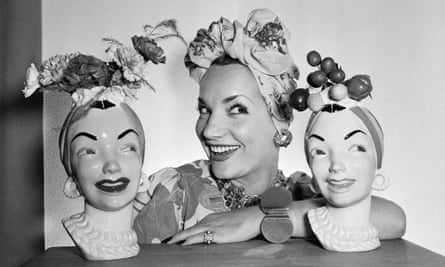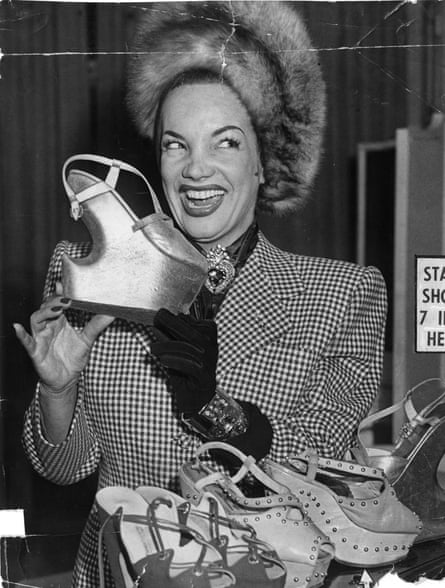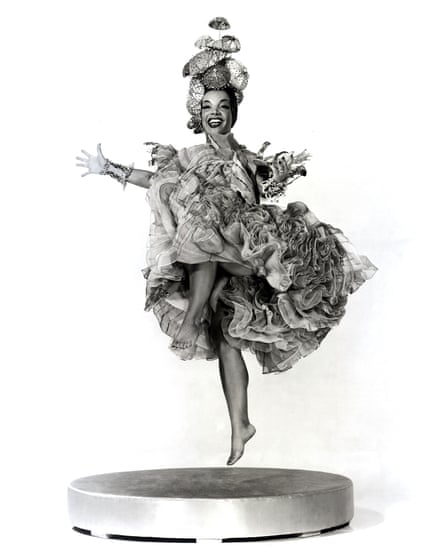Carmen Miranda’s name has become synonymous with frilly blouses and plastic fruit accessories, but did you know that the actor was also credited with popularising the platform shoe? In 1934, when Miranda was a samba singer in Brazil, she commissioned an orthopaedic cobbler in Rio de Janeiro to make thick-soled shoes to boost her height – she was just 5 ft tall. At around the same time, Moshe Kimmel would design a pair of platforms for Marlene Dietrich that later became known as the first “official” platforms – but the towering shoes were always essential to Miranda’s larger-than-life look. Her influence on fashion had broader consequences too: the colourful aesthetic that made her a hit in Hollywood was controversial back home in Brazil.

As the highest paid actress in Hollywood in the mid-1940s, Miranda introduced the US to an entirely new look, inspired by the outfits worn by Afro-Brazilian female street vendors in colonial times. These “baianas” (women from Bahia in north east Brazil) wore lace tops, gold jewellery and simple cloth turbans, and carried trays of fruit and other produce on their heads. This is how Miranda described them when she wore her baiana-inspired outfit for the first time, for the song O Que é Que a Baiana Tem? (What Does the Baiana Have?) in the Brazilian musical film Banana da Terra in 1939. In her stylised version, Carmen added sequins and a small imitation basket of fruit to her turban, which was made of lamé fabric.

American audiences first became aware of her aesthetic the same year, when Miranda left Rio for New York to perform in the Broadway production Streets of Paris. On the eve of her departure, she announced: “I am taking six really fancy baiana costumes with me … I asked them to pull out all the stops when designing them.” Her stage costumes became an overnight sensation, earning the diminutive singer a series of product endorsements for costume jewellery, ready-to-wear turbans, blouses and platform shoes, stocked by the main Manhattan department stores. In fact, the Bonwit Teller store even created mannequins with faces and poses copied directly from Miranda’s for their window displays. Now, not only was Miranda dressing in the baiana look; so too were the affluent customers of Bergdorf Goodman and Macy’s.

The adoption by Brazil’s most famous female film star of such a racially marked persona – traditionally associated with poor black women – was not without controversy; it shocked many in Brazil, who thought it inappropriate behaviour for a white woman (who was actually born in Portugal but now performed in elite venues in Rio). But, at the time, Afro-Brazilian popular culture – and samba music in particular – was also being appropriated by the regime of Brazilian president Getúlio Vargas, as part of a wider policy aimed at creating a sense of national identity that embraced a hitherto marginalised black population. From the president’s perspective, Miranda’s look was a hit and had his official seal of approval.

In Brazil, until the late 1930s, Miranda was known for a distinctly Hollywood-inspired fashion sense. Her previous film costumes included the full-length white organza dress with wide, frilly sleeves that she made for herself to wear in the 1935 Brazilian musical Alô, Alô, Brasil – highly reminiscent of one of the iconic gowns designed by Adrian for Joan Crawford in the 1932 Hollywood movie Letty Lynton – and the lamé trousers, tuxedo and top hat she wore in Alô, Alô, Carnaval in 1936, similar to those worn by Marlene Dietrich.

Her creation of this persona helped her to become a superstar, her popularity booming alongside a surging US interest in samba music and Brazilian culture – but it became a double-edged sword. Under contract with 20th Century Fox between 1940 and 1946, Miranda was forced to play stereotypical roles as fiery-tempered Latin American women who spoke comically fractured English and wore increasingly garish adaptations of the baiana costume, complete with ludicrously decorated turbans. This cultural straitjacket continued to dominate her screen performances, even when she went on to work with other studios.

Today, many Brazilians have mixed feelings about the image of Brazil that Miranda took to the wider world, as summed up in the title of the 1991 New York Times article about her by Brazilian singer-songwriter Caetano Veloso: Pride and Shame. Yet Miranda’s enduring cultural legacy is undeniably a testament to her creativity and aesthetic nous. As her Hollywood career took flight in the 1940s and 50s, homages by the likes of Judy Garland and Barbara Stanwyck, and a host of comic impersonations (often cross-dressed), caricatures and cartoon likenesses of Miranda’s look cemented her image among the public – key for commercial exploitation. Even now, echoes of Miranda’s “tropical”, “exotic”, “Latin” look abound in advertising (the recent campaign for PG Tips fruit teas, for example) and in womenswear, with fashion journalists and marketing teams perennially alluding to the Brazilian star to describe subtle reworkings of her signature look, in the form of frills, oversized costume jewellery, platform shoes and turbans.
Dr Lisa Shaw is a reader in Portuguese and Brazilian studies at the University of Liverpool and the author of Carmen Miranda, published by BFI/Palgrave Macmillan

Comments (…)
Sign in or create your Guardian account to join the discussion